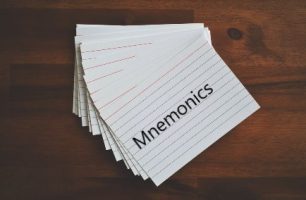Mnemonics (/nəˈmäniks/) are great tools for memorizing certain pieces of information like the spelling of words, grammar rules, names, facts, and almost anything else. It is believed that they were used in ancient Greece as early as in the fifth century BC. So, what do they look like?
Mnemonics can take different forms.
They can be melodies and jingles, such as the alphabet song that probably helped you remember the English alphabet.
Oftentimes, they are acronyms and one-word codes where each letter stands for a certain word. For example, the acronym “SVOPT” can help you remember the basic word order in English sentences (i.e.: Subject, Verb, Object, Place, Time). Another example is using the word “HOMES” for remembering the names of the Great Lakes (i.e.: Lake Huron, Lake Ontario, Lake Michigan, Lake Erie, and Lake Superior).
There are mnemonic expressions and sentences that are usually illogical but catchy, such as “big elephants are under trees in forests until light,” which can help you with the spelling of ‘beautiful.’ Another example is “Richard of York gave battle in Vain,” which is a mnemonic for remembering the colours of the rainbow (i.e.: red, orange, yellow, green, blue, indigo, and violet).
Mnemonics can also be rhymes or limericks. For example, the following rhyme can help you remember when to spell the word with “ie’ (e.g.: believe) or “ei” (e.g.: receive):
‘i’ before ‘e’
Except after ‘c,’
Or when sounded as ‘a’
As in neighbor and weigh
As you can see, mnemonics are useful memory systems and devices that can take different shapes and forms.
Can you create your own mnemonic? Please share it with us in the comments section below.

Facebook: https://www.facebook.com/canpacific
LinkedIn: https://www.linkedin.com/company/2923770/
Instagram: https://www.instagram.com/canpacific/
Youtube: https://www.youtube.com/channel/UCzHi6Jd15XOCu-mn_F8-QwQ
Special promotion: https://www.canpacificcollege.com/lead.php


